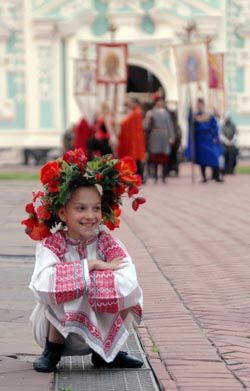How we saw off Princess Anna to Paris
Dramatized show “A Night in a Museum” held at St. Sophia Cathedral in Kyiv
Artistic happenings that take place in Ukraine’s national parks and museums are among the new ways of communicating with audiences. Organizers of such events say that the main thing is to spark interest, especially among young people, in our history, traditions, and ancient art. The latest “Night in a Museum” took place in one of the most outstanding and revered historic sites of Ukraine-St. Sophia Cathedral, whose Royal Gates were recently restored by Polish specialists.
A voievode and his wife welcomed guests at the entrance to the cathedral grounds. The voievode was a colorful personality: heavyset, with a resounding baritone, he was dressed in a satin shirt and cap, and cream-colored boots with turned-up toecaps. Some visitors, observing the confident manners of the host, imagined he was Yaroslav the Wise himself.
“Welcome to our holy places!” said the voievode, the host of the event. Not far from the entrance gate the Kyiv-based ensemble Puls treated the guests to an 11th-century traditional spring dance for girls. Then the adult members of the Volodar group sang the folk song “Oi, na Ivana, na Kupala” (Oh, on Saint John’s Eve), reminding us that the feast of St. John the Baptist is just around the corner.
The performance was followed by an improvised ritual dedicated to this holiday. With the spectators’ help, each of the singers received a ritual sapling adorned with multicolored ribbons. Even before the brief tour of the cathedral got underway, which was introduced by a kobza player’s rendition of the famous Ukrainian song “Ridna maty moia” (My dear mother), all the guests were in the right mood, ready to hear about things sublime and eternal.
The Museum of Ukrainian Amber was opened up to the guests in order to build a bridge spanning the eras. Amber not only bridges the 21st century with the 11th century but links our times with the more distant past, as it is the fossilized resin of coniferous trees that grew between 40 and 60 million years ago. The guests were treated to vodka flavored with amber and herbs, the kind that was consumed in the ancient past.
Meanwhile, everyone was getting ready for the arrival of Prince Yaroslav. We wanted to believe that what we were actually seeing took place hundreds of years ago. Along the road leading to the main entrance were girls dressed in identical white embroidered blouses with bright wreaths on their heads. The prince’s armed force arrived clad in iron armor and armed with sabers, while a monk sitting in front of the entrance to the cathedral began reading out loud from a book. He reminded us that “in the summer of 1037 Yaroslav founded a great city and the Golden Gate.” Church bells suddenly rang out: a recorded performance of bell- ringers playing a variety of religious motifs, one after the other.
The prince’s arrival was delayed, so the assembled guests took a closer look at the courtyard of the museum, noticing things they would have missed on an ordinary day. Yellow marigolds were planted in one of the flowerbeds, arranged in the pattern of one of the cathedral’s ornamental mosaic pieces.
Darkness was falling when the prince finally arrived in a carriage with his daughter Anna. Only then did we learn that this was the year 1049, when Yaroslav the Wise (actor Les Zadniprovsky from the Ivan Franko National Theater) gave his daughter Anna (played by Tetiana Zhyrko-Oleksenko) in marriage to King Henry I of France. We witnessed a church service in honor of this event.
The courtyard of the cathedral was the setting for a dramatization of Ivan Kocherha’s poem “Yaroslav the Wise,” which portrays the prince’s grief as he contemplates his daughter’s future life in uncivilized France. Yaroslav says that Anna does not know “how to leave all this behind.” The spectators saw how state interests took priority over personal wishes-Anna Yaroslavna got into a carriage and left her native land. To dispel all grievous thoughts and cheer himself up, Prince Yaroslav then invites everyone to a banquet.
The guests were not treated to the dishes served at the table in the 11th century: stuffed fish and vegetable kebabs are hardly foods from those ancient times. The organizers announced that a presentation of cuisine from the age of Kyivan Rus’ will be the next event in “A Night in a Museum” series.






